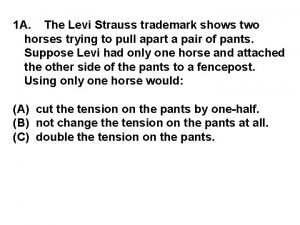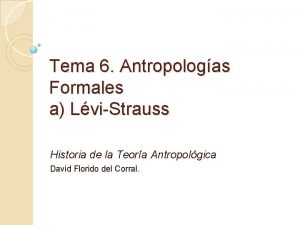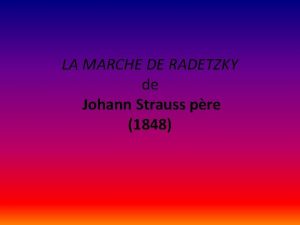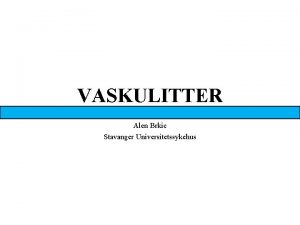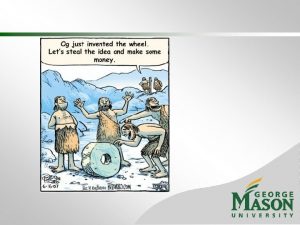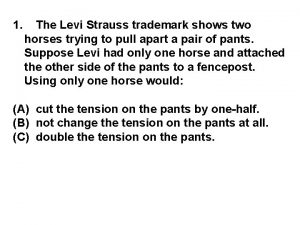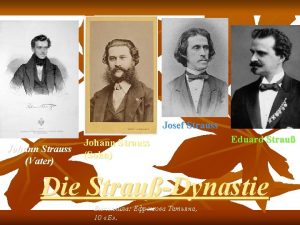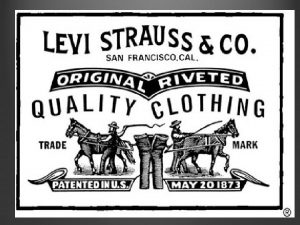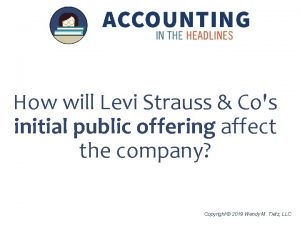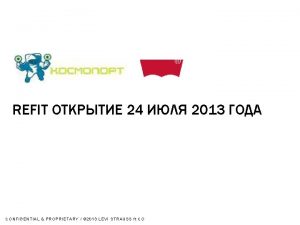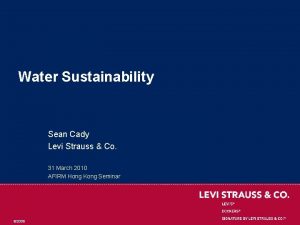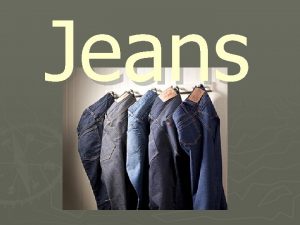1 A The Levi Strauss trademark shows two














- Slides: 14

1 A. The Levi Strauss trademark shows two horses trying to pull apart a pair of pants. Suppose Levi had only one horse and attached the other side of the pants to a fencepost. Using only one horse would: (A) cut the tension on the pants by one-half. (B) not change the tension on the pants at all. (C) double the tension on the pants.

1 B. Consider a (relatively light) electron orbiting a (much more massive) proton in a hydrogen atom. The force that the electron exerts on the proton is _____ the force the proton exerts on the electron. (A) greater than (B) equal to (C) less than

2. A constant force is exerted on a cart that is initially at rest on an air track. Friction between the cart and the track is negligible. The force acts for a short time interval and gives the cart a certain final speed. To reach the same final speed with a force that is only half as big, the force must be exerted on the cart for a time interval (A) (B) (C) (D) (E) four times as long as twice as long a equal to half as long as a quarter of that for the stronger force.

3. Suppose a person of inertia (or mass) 100 kg stands on top of 100 -kg platform attached to the ceiling using a pulley. How much force is needed to pull the person/platform up? Ignore friction and assume g = 10 m/s^2. (A) 2000 N (B) 1500 N (C) 1000 N (D) 667 N (E) 500 N (F) 334 N (G)167 N (H) the person won't go up no matter how hard (s)he pulls

5. A constant force is exerted for a short time interval on a cart that is initially at rest on an air track. This force gives the cart a certain final speed. The same force is exerted for the same length of time on another cart, also initially at rest, that has twice the mass of the first one. The final speed of the heavier cart is (A) one-fourth (B) four times (C) half (D) double (E) the same as that of the lighter cart.

7. Consider a person standing in an elevator that is accelerating upward. The upward normal force N exerted by the elevator floor on the person is (A) larger than (B) identical to (C) smaller than the downward weight W of the person. FN Fg ΣF = FN – Fg = ma

7 B. An object is at rest on an inclined surface. Compared to a horizontal surface, the force exerted by the inclined surface (normal force) on the object is (A) larger. (B) the same. (C) smaller. FN

8. A locomotive pulls a series of wagons. Which is the correct analysis of the situation? (A) The train moves forward because the locomotive pulls forward slightly harder on the wagons than the wagons pull backward on the locomotive. (B) Because action always equals reaction, the locomotive cannot pull the wagons-the wagons pull backward just as hard as the locomotive pulls forward, so there is no motion. (C) The locomotive gets the wagons to move by giving them a tug during which the force on the wagons is momentarily greater than the force exerted by the wagons on the locomotive. (D) The locomotive's force on the wagons is as strong as the force of the wagons on the locomotive, but the frictional force on the locomotive is forward a large while the backward frictional force on the wagons is small. (E) The locomotive can pull the wagons forward only if it weighs more than the wagons.

9. A car rounds a curve while maintaining a constant speed. Is there a net force on the car as it rounds the curve? (A) No-its speed is constant. (B) Yes. (C) It depends on the sharpness of the curve and the speed of the car.

10. In the 17 th century, Otto von Güricke, a physicist in Magdeburg, fitted two hollow bronze hemispheres together and removed the air from the resulting sphere with a pump. Two eight-horse teams could not pull the halves apart even though the hemispheres fell apart when air was re- admitted. Suppose von Güricke had tied both teams of horses to one side and bolted the other side to a heavy tree trunk. In this case, the tension on the hemispheres would be (A) twice (B) exactly the same as (C) half what it was before.

11. You are pushing a wooden crate across the floor at constant speed. You decide to turn the crate on end, reducing by half the surface area in contact with the floor. In the new orientation, to push the same crate across the same floor with the same speed, the force that you apply must be about (A) (B) (C) (D) (E) four times as great twice as great equally great half as great one-fourth as great as the force required before you changed the crate's orientation.

12. An object is held in place by friction on an inclined surface. The angle of inclination is increased until the object starts moving. If the surface is kept at this angle, the object: (B) (C) (D) (E) slows down. moves at uniform speeds up. none of the above

13. Consider a horse pulling a buggy along a hilly road. Is the following statement true? The weight of the horse and the normal force exerted by the ground on the horse are always equal and opposite according to Newton's third law. (A) yes (B) no

ANSWERS: 1 A. B 1 B. B 2. B 3. A 5. C 7. A 7 B. C 8. A 9. B 10. A 11. C 12. D 13. B
 The levi strauss trademark shows two horses
The levi strauss trademark shows two horses Levi strauss teoria estructuralista
Levi strauss teoria estructuralista Saussure levi strauss
Saussure levi strauss Levi strauss bricoleur
Levi strauss bricoleur Levi strauss theory media
Levi strauss theory media Levi levi lama sabachthani
Levi levi lama sabachthani Segmental thrombosing vasculitis
Segmental thrombosing vasculitis Alexis strauss
Alexis strauss Johann strauss père marche de radetzky
Johann strauss père marche de radetzky Analisis data kualitatif model strauss dan corbin
Analisis data kualitatif model strauss dan corbin Dr gordon jay strauss
Dr gordon jay strauss Churg strauss vaskulitt
Churg strauss vaskulitt Resolution of flowers for algernon
Resolution of flowers for algernon Boeing trademark
Boeing trademark Difference between copyright and patent
Difference between copyright and patent
